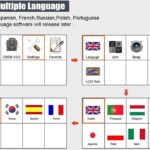For car enthusiasts and everyday drivers alike, understanding your vehicle’s performance is paramount. Modern vehicles are equipped with sophisticated computer systems that monitor a vast array of engine and transmission data. An Obd2 Digital Gauge is your window into this data, providing real-time insights directly from your car’s onboard computer. By simply plugging into your engine’s diagnostic port, you gain access to crucial information, enhancing your driving experience and vehicle awareness.
What exactly can an OBD2 digital gauge offer? Devices like the BIM-01-2 OBD-II (J1850/CAN) Interface from Dakota Digital are designed to extract and display this valuable data. Connecting to your vehicle’s ECM (Engine Control Module) via the OBD-II port, these gauges can present a wealth of information on a clear, digital display.
The core data points available on most OBD2 compliant vehicles typically include:
- Speedometer: A precise digital readout of your vehicle’s speed.
- Tachometer: Engine RPM (Revolutions Per Minute), crucial for performance driving and monitoring engine health.
- Engine Temperature: Real-time coolant temperature monitoring, vital for preventing overheating.
- Check Engine Indicator: Integration with the check engine light system, potentially offering more detailed diagnostic information than the standard dashboard warning.
Beyond these common parameters, many vehicles also offer access to vehicle-specific data through the OBD-II port. Depending on your car’s sensors and ECM capabilities, an obd2 digital gauge might also display:
- Intake Air Temperature: Monitoring the temperature of the air entering your engine, important for performance tuning and efficiency.
- Transmission Temperature: Critical for vehicles used for towing or performance driving, preventing transmission damage from overheating.
- Ambient Air Temperature: The outside air temperature.
- Gear Position: Displaying the current gear selected in automatic transmissions.
- Oil Pressure: A direct indication of engine lubrication system health.
- Boost Pressure: For turbocharged or supercharged vehicles, displaying turbocharger/supercharger boost levels.
It’s important to note that the availability of these vehicle-specific parameters can vary. Factors such as the vehicle’s make, model, year, and any modifications to the ECM can influence what data is accessible. Dakota Digital, for example, points out that while additional data like Intake Temp, Transmission Temp, Ambient Air Temp, Oil Pressure, and Gear Position may be available, they cannot guarantee their presence or accuracy due to ECM and sensor variations across different vehicles. The accuracy of readings like Coolant Temp, Intake Temp, Transmission Temp, Ambient Air Temp, Oil Pressure, Boost, and Gear Position is ultimately dependent on the vehicle’s ECM and the functionality of its original equipment manufacturer (OEM) sensors.
The BIM-01-2 and similar obd2 digital gauges are specifically engineered to decode information transmitted via OBD-II using J1850 and CAN protocols. Compatibility extends to OBD-II protocols SAE J1850 VPW, SAE J1850 PWM, and ISO 15765 CAN 500k 11 bit identifiers adhering to the SAE J1979 PID protocol. These gauges are designed to seamlessly integrate with Dakota Digital Instrument Systems such as the GRFX, RTX, HDX, VHX, and VFD3 series, typically those featuring a black plastic control module. For older BIM-compatible control boxes with a 3.5mm headphone jack BIM input, a part number 394194 adapter harness is available. It’s crucial to understand that earlier instrument systems with aluminum control modules are not compatible with BIM connectivity.
If you are unsure about the compatibility of an obd2 digital gauge with your specific vehicle, it’s always recommended to consult with the manufacturer or a qualified technician. For instance, Dakota Digital encourages customers to contact their sales or tech department with any compatibility concerns. Furthermore, it’s worth noting that certain vehicle configurations, such as GM Connect & Cruise packages, may not transmit all data parameters. Specifically, gear position data may not be available in these setups, preventing the obd2 digital gauge from displaying this information.
In conclusion, an obd2 digital gauge is a powerful tool for modern drivers seeking to enhance their understanding of their vehicle’s performance. By providing real-time access to a wealth of engine and transmission data, these gauges empower drivers with valuable insights, contributing to improved vehicle maintenance, performance monitoring, and overall driving awareness. Whether you’re a seasoned car enthusiast or simply looking to stay informed about your vehicle’s health, an obd2 digital gauge is an excellent upgrade.
